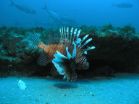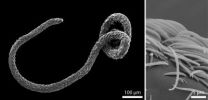(Press-News.org) San Francisco, September 14, 2014—Patient-reported data indicates that when Manuka honey is prescribed for esophagitis pain during radiation therapy (RT), it is not more effective than standard medical care, according to research presented today at the American Society for Radiation Oncology's (ASTRO's) 56th Annual Meeting.
Esophagitis, inflammation that damages tissues of the esophagus and causes discomfort, is a common and temporary side effect experienced by the majority of lung cancer patients undergoing RT. Small studies have previously been conducted to evaluate if honey can prevent the loss of the normal surface of the mouth or throat caused by RT. It is important to reduce esophagitis pain so that patients' do not forgo eating; maintaining patients' positive nutritional status is vital during cancer treatment.
This study assessed the use of Manuka honey, a honey from New Zealand that is a standardized, medical grade honey. The randomized, phase II trial enrolled 163 lung cancer patients at 13 cancer centers who were undergoing concurrent chemotherapy and RT. Of the study group, ≥30 percent of the patients had received 60 Gy of RT to the espophagus (V60). There were no statistically significant differences in pretreatment characteristics within the study group.
Patients were assigned to three groups based upon treatment for esophagitis—56 patients in Arm 1 received standard supportive care; 53 patients in Arm 2 received 10 ml of Manuka honey orally, four times per day; and 54 patients in Arm 3 received one lozenge, consisting of 10 ml of dehydrated Manuka honey, four times per day. The honey was administered on the first day of treatment and continued throughout RT.
After four weeks of RT treatment with and without Manuka honey, patients were asked to assess their pain during swallowing using the Numerical Pain Rating Scale (NPRS) scale, with a zero indicating "no pain," a five indicating "moderate pain," and a 10 indicating "worst possible pain." The study was designed to detect a 15 percent relative reduction of change in NPRS score, corresponding to a mean change score of 3.1 in Arms 2 and 3, as compared with Arm 1. The study concluded that there was no significant difference in levels of pain reported by patients within the three groups (mean change scores of 2.7, 2.1 and 2.1, respectively; p=0.73 for Arm 1 vs. Arm 2, p=0.68 Arm 1 vs. Arm 3).
Additionally, researchers evaluated secondary endpoints, such as the trend of the patients' pain over time, opiod use, adverse events, weight loss, quality of life, dysphagia and nutritional status. There were no differences in any of the secondary endpoints.
"The results from our study were somewhat unexpected since three previous trials had indicated that honey worked, and reducing esophagitis is important so that patients can continue eating their normal diet," said lead study author Lawrence Berk, MD, chief of radiation oncology, Morsani School of Medicine at the University of South Florida, Tampa. "A larger trial was just completed in Canada for a similar problem—mouth and throat pain during head and neck RT—and that trial also found no benefit with the honey. Both the Canadian study and our trial used Manuka honey, whereas previous trials all used a local honey. This is often a problem in using natural products–each batch or type of product may be different, so it is hard to reproduce the effects seen by others. Currently, honey cannot be recommended for every patient to use for esophagitis pain relief. However, it is safe and inexpensive, so if patients want to try it, there is probably little harm. Patients with diabetes should be cautious with honey because it does have a high sugar load."
The abstract, "Randomized Phase II Trial of Best Supportive Care, Manuka Honey Liquid and Manuka Honey Lozenges for Prevention of Radiation Esophagitis During Chemotherapy and Radiotherapy for Lung Cancer," will be presented in detail during a scientific session at ASTRO's 56th Annual Meeting at 3:15 p.m. Pacific time on Sunday, September 14, 2014. To speak with Dr. Berk, please call Michelle Kirkwood on September 14 – 17, 2014, in the ASTRO Press Office at San Francisco's Moscone Center at 415-978-3503 or
415-978-3504, or email michellek@astro.org.
ASTRO's 56th Annual Meeting, to be held at the Moscone Center in San Francisco, September 14-17, 2014, is the nation's premier scientific meeting in radiation oncology. The 2014 Annual Meeting is expected to attract more than 11,000 attendees including oncologists from all disciplines, medical physicists, dosimetrists, radiation therapists, radiation oncology nurses and nurse practitioners, biologists, physician assistants, practice administrators, industry representatives and other health care professionals from around the world. Led by ASTRO President Bruce G. Haffty, MD, FASTRO, a radiation oncologist specializing in breast cancer, the theme of the 2014 Meeting is "Targeting Cancer: Technology and Biology," and the Presidential Symposium, "Local-regional Management of Breast Cancer: A Changing Paradigm," will feature Jay R. Harris, MD, FASTRO, and Thomas A. Buchholz, MD, FASTRO, to highlight recent practice-changing, landmark studies and current developments in the local-regional management of breast cancer. ASTRO's four-day scientific meeting includes presentation of up to four plenary papers, 360 oral presentations, 1,862 posters and 144 digital posters in more than 50 educational sessions and scientific panels for 20 disease-site tracks. Three keynote speakers will address a range of topics including oncologic imaging, biology and targeting in oncology, and human error and safety concerns: Hedvig Hricak, MD, PhD, Chair of the Department of Radiology and the Carroll and Milton Petrie Chair at Memorial Sloan Kettering Cancer Center; Frank McCormick, PhD, FRS, DSc (hon), Professor Emeritus and the David A. Wood Distinguished Professor of Tumor Biology and Cancer Research of the University of California at San Francisco Helen Diller Family Comprehensive Cancer Center; and Sidney Dekker, PhD, MA, MSc, Professor and Director of the Safety Science Innovation Lab at Griffith University, Brisbane, Australia.
INFORMATION:
ABOUT ASTRO
ASTRO is the premier radiation oncology society in the world, with more than 10,000 members who are physicians, nurses, biologists, physicists, radiation therapists, dosimetrists and other health care professionals that specialize in treating patients with radiation therapies. As the leading organization in radiation oncology, the Society is dedicated to improving patient care through professional education and training, support for clinical practice and health policy standards, advancement of science and research, and advocacy. ASTRO publishes two medical journals, International Journal of Radiation Oncology, Biology, Physics and Practical Radiation Oncology; developed and maintains an extensive patient website, http://www.rtanswers.org; and created the Radiation Oncology Institute, a non-profit foundation to support research and education efforts around the world that enhance and confirm the critical role of radiation therapy in improving cancer treatment. To learn more about ASTRO, visit http://www.astro.org.
2014 American Society for Radiation Oncology (ASTRO) 56th Annual Meeting
News Briefing, Monday, September 15, 2014, 11:00 a.m. Pacific time
Scientific Session: Sunday, September 14, 2014, 3:15 – 4:45 p.m. PT, the Moscone Center
2065 Randomized Phase II Trial of Best Supportive Care, Manuka Honey Liquid and Manuka Honey Lozenges for Prevention of Radiation Esophagitis During Chemotherapy and Radiotherapy for Lung Cancer
Author Block: L. B. Berk1, S. Deshmukh2, S. E. Fogh3, K. Roof4, S. Yacoub5, T. J. Gergel6, K. Stephans7, A. Rimner8, A. S. DeNittis9, J. Pablo10, J. M. Rineer11, A. Chakravarti12, D. Watkins Bruner13, 1University of South Florida, Tampa, FL, 2Radiation Therapy Oncology Group, Philadelphia, PA, 3University of California - San Francisco, Sna Francisco, CA, 4Southeast Cancer Control Consortium., Inc CCOP, Charlotte, NC, 5York Cancer Center, Gettysburg, PA, 6Geisinger Medical Center, Danville, PA, 7Cleveland Clinic, Cleveland, OH, 8MSKCC, New Yor City, NY, 9Main Line CCOP, Wynnewood, PA, 10Lewis Cancer & Reseach Pavilion at St. Joseph's/Chandler, Savannah, GA, 11Orlando Regional Medical Center, Orlando, FL, 12The James Cancer Hospital at OSU, Columbus, OH, 13Emory University, Atlanta, GA
Purpose/Objective(s): Several small randomized trials showed that honey is effective for the prevention and treatment of radiation mucositis. There is currently no proven method of preventing radiation esophagitis. Therefore a standardized, medical grade honey, Manuka Honey from New Zealand, was chosen as a potential treatment for radiation esophagitis. It is also not known if honey is active through an intrinsic property of the honey or from its osmolality. This trial compared liquid honey, honey lozenges made by dehydrating the honey and standard supportive care.
Materials/Methods: Patients were stratified by V60 of the esophagus ≥ 30% then randomized between best supportive care (Arm 1), 10 ml of Manuka honey four times a day (Arm 2) or 1 lozenge (10 ml of dehydrated Manuka honey) four times a day (Arm 3) during concurrent chemotherapy and radiotherapy. Honey began on the first day of treatment and continued throughout radiotherapy. The primary endpoint was pain on swallowing on an eleven point (0-10) scale at 4 weeks (Numerical Pain Rating Scale, NPRS). The study was designed to detect a 15% relative reduction of change in NRPS score, corresponding to a mean change score of 3.1, in Arms 2 and 3 as compared with Arm 1. Using a t-test with a Bonferroni-adjusted type I error of 0.05, 135 patients were required to achieve 80% power. Secondary endpoints were the trend of the pain over time, opiod use, adverse events, weight loss, quality of life as measured by the PRO-CTCAE and EORTC QLQ-C30, dysphagia and nutritional status
Results: 56 patients were randomized to Arm 1, 53 patients were randomized to Arm 2 and 54 patients to Arm 3. 4 cases were excluded from analysis. There were no statistically significant differences in pretreatment characteristics. Grade 3 or higher adverse events related to the protocol treatment were: Arm 1 - 0, Arm 2 - 11 and Arm 3 -2. There was no significant difference in the primary endpoint of change the NPRS at 4 weeks in the arms (mean change scores of 2.7, 2.1 and 2.1, respectively, p=0.73 for Arm 1 vs. Arm 2, 0.68 Arm 1 vs. Arm 3). There were no differences in any of the secondary endpoints.
Conclusions: Manuka honey as prescribed within this protocol was not superior to best supportive care in preventing radiation esophagitis.
Author Disclosure Block: L.B. Berk: None. S. Deshmukh: None. S.E. Fogh: None. K. Roof: None. S. Yacoub: None. T.J. Gergel: None. K. Stephans: None. A. Rimner: None. A.S. DeNittis: None. J. Pablo: None. J.M. Rineer: None. A. Chakravarti: None. D. Watkins Bruner: None.
Manuka honey does not decrease pain of radiation-induced esophagitis for lung cancer patients
2014-09-15
ELSE PRESS RELEASES FROM THIS DATE:
Patient-reported data shows RT does not increase risk of lymphedema in node-negative BC patients
2014-09-15
San Francisco, September 14, 2014—A secondary analysis of the National Surgical Adjuvant Breast and Bowel Project B-32 trial (Krag 2010) indicates that radiation therapy (RT) does not increase the incidence of lymphedema in patients with node-negative breast cancer, according to research presented today at the American Society for Radiation Oncology's (ASTRO's) 56th Annual Meeting.
The original NSABP B-32 study was a randomized trial of sentinel node biopsy (SNB) versus SNB + axillary lymph node dissection (ALND) in 5,611 women with clinically node-negative breast cancer. ...
Improved survival shown in early-stage Hodgkin's Disease patients who receive radiation therapy
2014-09-15
San Francisco, September 14, 2014—Patients with stage I and II Hodgkin's Disease who receive consolidated radiation therapy (RT) have a higher 10-year survival rate of 84 percent, compared to 76 percent for patients who did not receive RT; and, the data also shows a decrease in utilization of RT, according to research presented today at the American Society for Radiation Oncology's (ASTRO's) 56th Annual Meeting.
Researchers evaluated clinical features and survival outcomes among 41,502 patients diagnosed with stage I and II Hodgkin's Disease from 1998 to 2011 from a prospectively ...
Advanced esophageal cancer patients who receive RT alone experience less problems when swallowing
2014-09-15
San Francisco, September 14, 2014—Radiation therapy (RT) alone is as effective in decreasing swallowing complications experienced by advanced esophageal cancer patients as RT combined with chemotherapy, thus allowing patients to forgo chemotherapy, according to research presented today at the American Society for Radiation Oncology's (ASTRO's) 56th Annual Meeting.
In this international study that included sites in Australia, New Zealand, Canada and the United Kingdom, researchers assessed the use of palliative chemotherapy combined with RT, or chemoradiotherapy (CRT), ...
Study finds warming Atlantic temperatures could increase range of invasive species
2014-09-15
"The results will allow us to better understand how the fish communities might shift under different climate change scenarios and provide the type of environmental data to inform future decisions relating to the management and siting of protected areas," said Paula Whitfield, a research ecologist at NOAA's National Centers for Coastal Ocean Science (NCCOS) and lead author of the study.
The North Carolina reefs lie within the temperate-tropical transition zone, where historically, both temperate and tropical species live, at their respective range limits. However, water ...
'Jaws' lived in Doncaster
2014-09-15
Sharks, swamps and a tropical rainforest teeming with life – it's not what comes to mind when you think of Yorkshire, England. But for the first time evidence of Doncaster's 310-million-year-old past, including a fossilised shark egg case, has been discovered in a derelict mining tip.
Some of the fossilised plants and creatures may even be new to science, and as well as the egg case, several horseshoe crabs and some previously unrecorded seed pods are amongst the finds. All had been preserved in rocks that formed within the coal and shale deposits in what is one of only ...
Dairy consumption linked to lower blood pressure and cardiovascular disease risk
2014-09-15
Rosemont, Ill., September 15, 2014: Globally, cardiovascular disease (CVD) claims 17 million lives each year, while complications from high blood pressure take an additional 9.4 million.1 New research presented by international scientists at the 12th Euro Fed Lipid Congress in Montpellier, France on September 15, 2014, suggests that milk consumption and dairy may play a beneficial role.
At the Milk and Dairy Products in Human Health session, the association between milk and risk for hypertension and CVD was examined by Dr. Sabita S. Soedamah-Muthu from Wageningen University ...
Think big! Bacteria breach cell division size limit
2014-09-15
This news release is available in German.
The life of a cell is straightforward: it doubles, divides in the middle and originates two identical daughter cells. Therefore, it has been long assumed that cells of the same kind are similarly sized and big cells cannot divide symmetrically. Silvia Bulgheresi's team, University of Vienna, revealed that two non-model bacteria divide regularly despite growing so long to be perceivable by the naked eye. These findings have been published in the renowned journal Nature Communications.
"The microorganisms thriving on the ...
Martian meteorite yields more evidence of possibility of life on Mars
2014-09-15
A tiny fragment of Martian meteorite 1.3 billion years old is helping to make the case for the possibility of life on Mars, say scientists.
The finding of a 'cell-like' structure, which investigators now know once held water, came about as a result of collaboration between scientists in the UK and Greece. Their findings are published in the latest edition of the journal Astrobiology.
While investigating the Martian meteorite, known as Nakhla, Dr Elias Chatzitheodoridis of the National Technical University of Athens found an unusual feature embedded deep within the ...
Mindfulness protects adults' health from the impacts of childhood adversity
2014-09-15
Adults who were abused or neglected as children are known to have poorer health, but adults who tend to focus on and accept their reactions to the present moment—or are mindful—report having better health, regardless of their childhood adversity. These findings, to be published in the October issue of Preventive Medicine, are based on the first study ever conducted to examine the relationship between childhood adversity, mindfulness, and health.
Led by Robert Whitaker, professor of public health and pediatrics at Temple University, the researchers surveyed 2,160 adults ...
The creation of the Vuoksi River preceded a significant cultural shift
2014-09-15
The creation of the Vuoksi River and the subsequent rapid decrease in the water level of Lake Saimaa approximately 6,000 years ago revealed thousands of square kilometres of new, fertile land in eastern Finland. A multidisciplinary research project organised by University of Helsinki researchers has studied the role that the decrease in water levels has played in the interaction between nature and humans. After dramatic shifts in the waterways, human life in the area underwent significant changes and gave rise to a new, innovative culture. This stemmed from an increase ...



